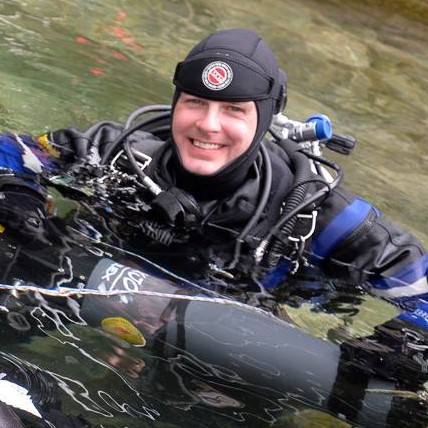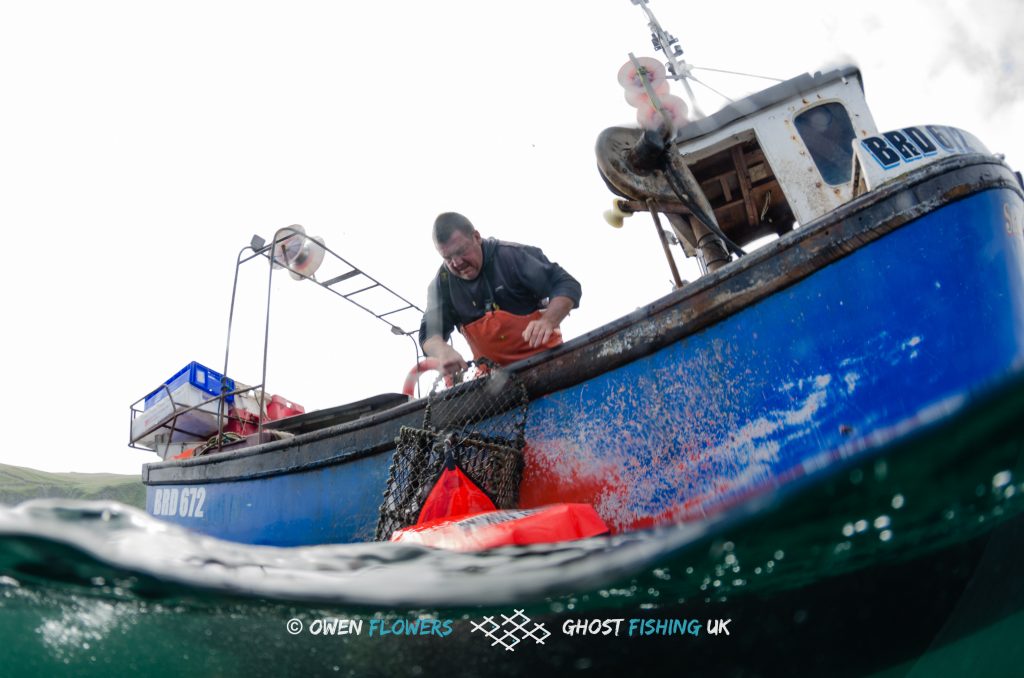 Returning creels to the fisherman who owns them. Image: Owen Flowers
Returning creels to the fisherman who owns them. Image: Owen Flowers
Twenty-eight creels, used for catching crabs and lobsters, returned to two inshore fishing boats. These are the tools of their trade, how fishermen make their living. Losing them is a costly day at sea. Recovering them is not an easy task, although they try hard to.
The core of Ghost Fishing UK’s mission is to remove from the sea abandoned, lost or discarded fishing gear—ALDFG, more commonly called ‘ghost gear’. It continues to catch marine life and will eventually break down into microplastics. It needs to come out.
Diver recovery of ghost gear is not an easy task either, although skilled divers make it look simple.
As Richard Harpin sat aboard the dive boat Silver Sky leaving Eyemouth harbour for the wreck of the Glanmire a wave of apprehension came over him. A diver who’d trained with PADI, BSAC and GUE, he was certainly up to the task, but this was his first ‘live lift’, with several teammates he’d only just met, on a wreck he’d never dived before.
Dropping into the water he relaxed. Diving had been his hobby since university days, on and off for more than a dozen years now. Teammates Wayne Heelbeck and Sergej Maciuk put him at his ease. They descended together thirty metres into the cold, gloomy, green water to begin their search for ghosts on the wreck.
“I generally like wrecks,” says Richard. “They appeal more to my interest in history and engineering, but I’m getting more into marine life as I learn more about it. I can work my way around a wreck and identify things and contextualise them. I never had that until recently with marine life, but my increasing knowledge and understanding has driven my interest in ghost fishing as it allows me to understand what I’m looking at, and anticipate what will be living where I am diving.”
In the water are three other teams. Spreading out across the wreck, and swimming forward from the engine the two large steam boilers come into view from twenty-four metres. They are studded with deadmen’s fingers, soft corals that grow quickly and in abundance on the hard, metallic surfaces. The boilers stand proud amongst flat plates that were once the ship’s hull before time and winter storms took their toll.
A large fishing net is shrouding the bow. Close-by a tumbling heap of creels, and enough rope to catch an unwary diver. The team attach a line and marker buoy, inflating it with gas to send it shooting to the surface. They are now certain we will find the creels again. A plan for recovery must be hatched.
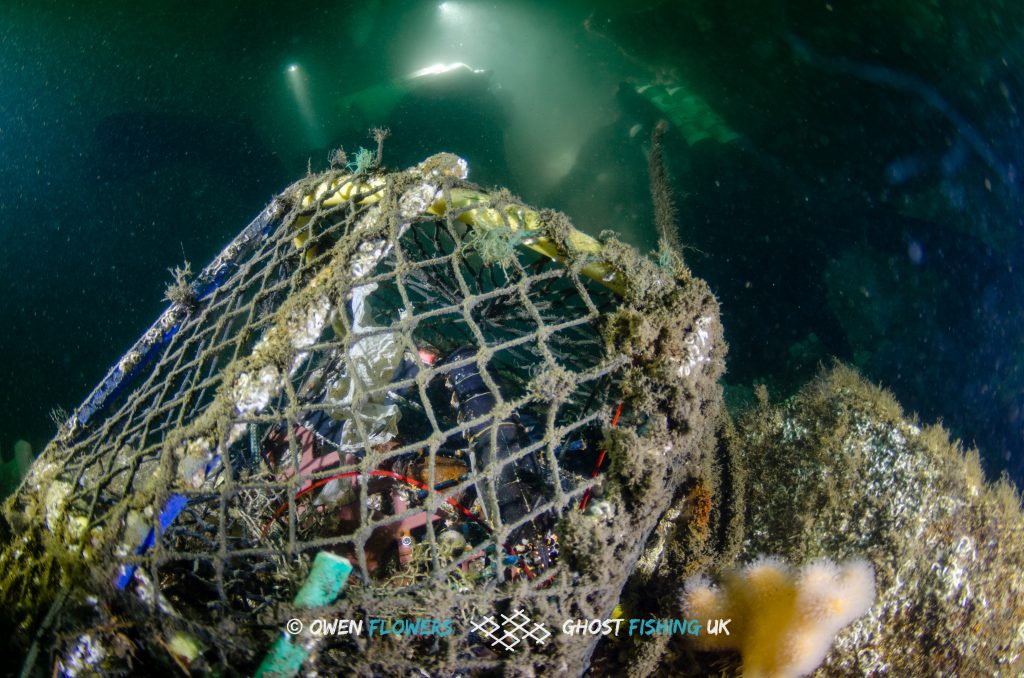 Lobster caught in a lost creel. Image: Owen Flowers
Lobster caught in a lost creel. Image: Owen Flowers
The next day there are no white horses prancing across the sea, but the swell is sharply tossing the boat as they leave the harbour. The divers are hot with their drysuits already zipped up, and are eager to enter the water.
Arriving on site Peter Ellwood briefs the group. One team will tackle the creels, while others set about the net and document the recovery with photography. Pete and Darren Morley, the team’s most experienced ghost fishers, will bring up the rear to clean up what the others are unable to finish in time.
Descending the line from the surface marker the creel team (Rob Corby, Jamie Vaughan and I) quickly find our target and set about attaching lift bags. A length of rope drifts ominously above the working divers, threatening entanglement and making me wary. Slowly adding gas to the lift bags hauls the creels, eighteen in all, from the seabed. But instead of carrying on they stop, held fast by an unseen force. We begin to search, lighting up the underside of the creels with our powerful primary lights, to reveal a piece of net snagged on a hull rib.
Time is short. We will need to stop briefly midwater to allow nitrogen to escape our bodies before returning to the surface. Working together one diver twists the net, as another cuts, the safety diver keeping a close eye on the time. The final cut is made, and the creels drift slowly upwards. With a quick thumbs up we are leaving too.
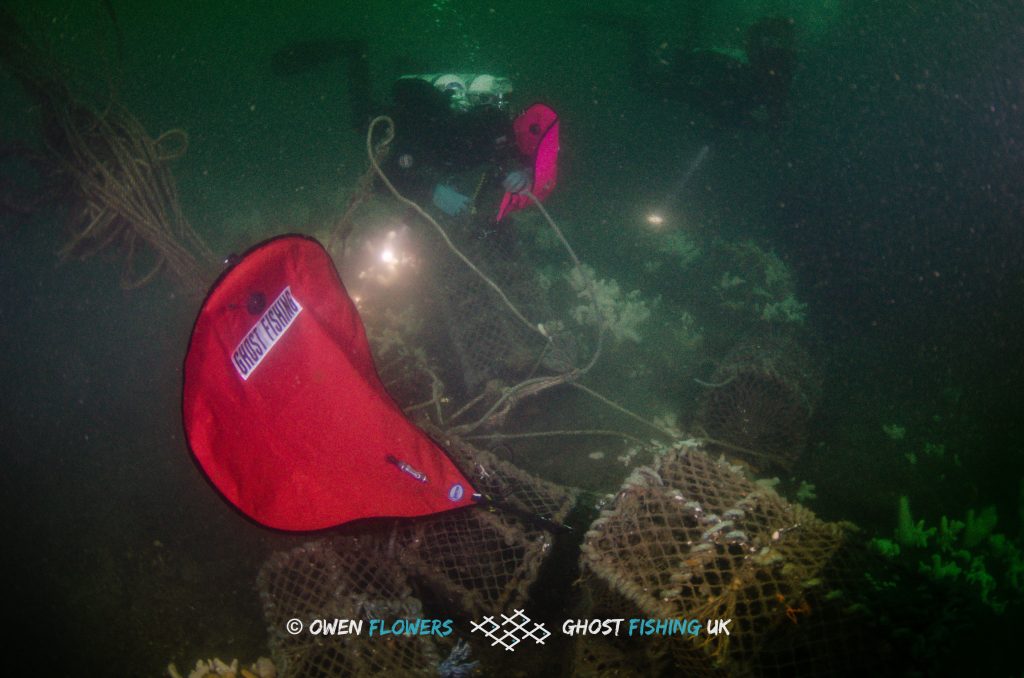 | 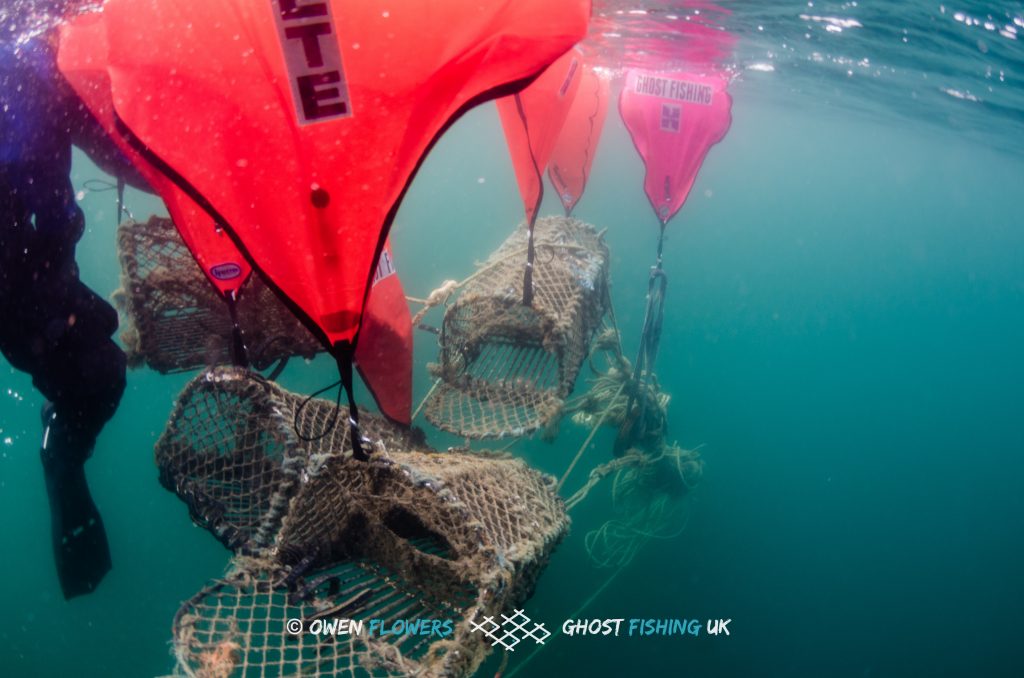 |
Diver attaching lift bags to creels. Image: Owen Flowers | Creels on the sea surface. Image: Owen Flowers |
Once everyone is safely back on the surface, Davey, skipper of the the fishing boat Danny Boy is able to recover his creels.
The Silver Sky begins her journey back to port and Richard reflects, “I was particularly happy we were able to give the pots straight back to the fishermen. I think we should be supporting local small producers where possible as well as the environment, and the cost of pots show the significance of loss to local producers.”
Ghost gear affects the fishery as it traps the fishermens’ quarry. They are keen to retrieve lost creels because of the financial cost and also to avoid depleting stocks of crabs and lobsters unnecessarily. Where lost creels cannot be hooked up by the fishermen themselves, volunteer diver recovery has proved to be a viable option.
| Diver profile: Richard Harpin | |
| I originally learned to dive in 1997 with PADI. I did my commercial diving license (HSE Part III) in 1998 as I thought it would be a good way to make money whilst at university, but I ended up in Coventry so no diving work there! I then dived irregularly through university until 2002 when I joined the army. Fast forward to 2009 and decided I needed a hobby. I joined a BSAC club (Trident 363) with my now wife, and worked through the Ocean and Sport Diver courses by proxy as she trained and I refreshed. I completed GUE Fundamentals in 2014 with Rich Walker, then Rec 3, then Tech 1 last year with JP Bresser. I’m now BSAC Dive Leader and member of Huddersfield BSAC 18 club. I heard about Ghost Fishing UK through the GUE UK posts initially and some of the outreach work at TekCamp. This was my first recovery dive, and I really enjoyed it! |
We are grateful to Healthy Seas and Eyemouth Harbour Trust for supporting this mission.

